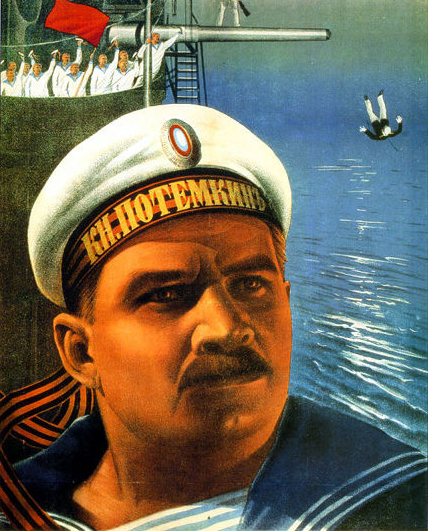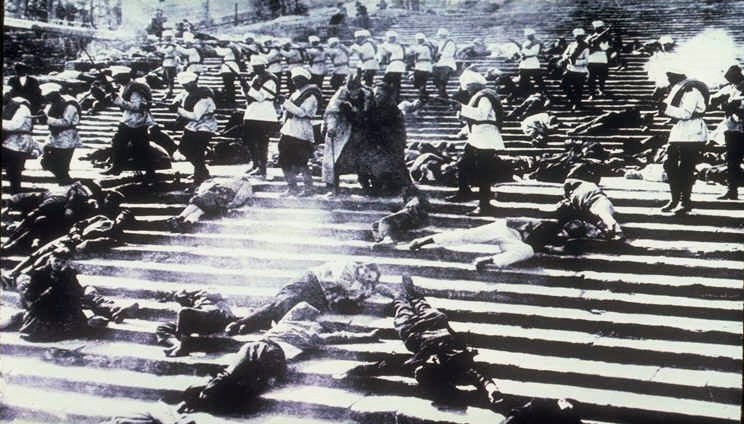Battleship Potemkin is a 1925 Soviet silent revolutionary propaganda film directed by Sergei Eisenstein and produced by Mosfilm. It presents a dramatized version of the mutiny that occurred in 1905 when the crew of the Russian battleship Potemkin rebelled against their officers.


Revolutionary Propaganda and Theories of Montage and Emotion
After the success of Strike (1924), Sergei Eisenstein was commissioned by the Soviet government to make a film commemorating the uprising of 1905. Eisenstein’s scenario, boiled down from what was to have been a multipart epic of the occasion, focused on the crew of the battleship Potemkin. Fed up with the extreme cruelties of their officers and their maggot-ridden meat rations, the sailors stage a violent mutiny. This, in turn, sparks an abortive citizens’ revolt against the Czarist regime.
The film’s centerpiece is staged on the Odessa Steps, where in 1905 the Czar’s Cossacks methodically shot down rioters and innocent bystanders alike. To Eisenstein, this single bloody incident was the crucible of the successful 1917 Bolshevik revolution, and the result was the “Odessa Steps sequence,” which is often considered the most famous sequence ever filmed; it is certainly one of the most imitated, perhaps most overtly by Brian De Palma in The Untouchables (1987).
This triumph of Eisenstein’s “rhythmic editing” [montage] technique occurs in the middle of film, not as the climax, as more current film structure might do it. All the actors in the film were amateurs, selected by Eisenstein because of their “rightness” as types for their roles. Pictorial quality varies from print to print, but even in a duped-down version, Battleship Potemkin is must-see cinema. ~ Hal Erickson, Rovi
“Revolution is War. Of all the wars known in history, it is the only lawful, rightful, just, and truly great war… In Russia, this war has been declared and begun.” — Lenin, 1905
httpvh://youtu.be/V8KA6lOh79Q
Battleship Potemkin, Directed by Sergei Eisenstein
Odessa Steps Sequence
One of the most celebrated scenes in the film is the massacre of civilians on the Odessa Steps. This sequence has been assessed as a “classic” and one of the most influential in the history of cinema. In the scene, the Tsar’s soldiers in their white summer tunics march down a seemingly endless flight of steps in a rhythmic, machine-like fashion, firing volleys into a crowd. A separate detachment of mounted Cossacks charges the crowd at the bottom of the stairs. The victims include an older woman wearing pince-nez, a young boy with his mother, a student in uniform and a teenage schoolgirl. A mother pushing an infant in a baby carriage falls to the ground dying and the carriage rolls down the steps amidst the fleeing crowd.
httpvh://youtu.be/qxaefqC-k90
BATTLESHIP POTEMKIN: The Complete Odessa Steps Sequence, music is re-recording of the original score by Edmund Meisel, commissioned by the Deutsche Kinemathek – Museum fur Film und Fernsehen, performed by the Babelsberg Orchestra, conducted by Helmut Imig.
The massacre on the steps, although it never actually took place, was based on the fact that there were widespread demonstrations in the area, sparked off by the arrival of the Potemkin in Odessa Harbor, and both The Times and the resident British Consul reported that troops fired on the crowds; deaths were reportedly in the hundreds. Roger Ebert wrote, “That there was, in fact, no czarist massacre on the Odessa Steps scarcely diminishes the power of the scene … It is ironic that [Eisenstein] did it so well that today, the bloodshed on the Odessa steps is often referred to as if it really happened.”


Updated 25 June 2018













Pingback: ‘Solaris’ – Tarkovsky’s Vision Beyond an Urban Future | WilderUtopia.com
Pingback: The Real Imagination of Artist Francis Bacon | WilderUtopia.com
Pingback: Gogol's Vision of Metaphysical Unraveling Amid the Dark Arts | WilderUtopia.com